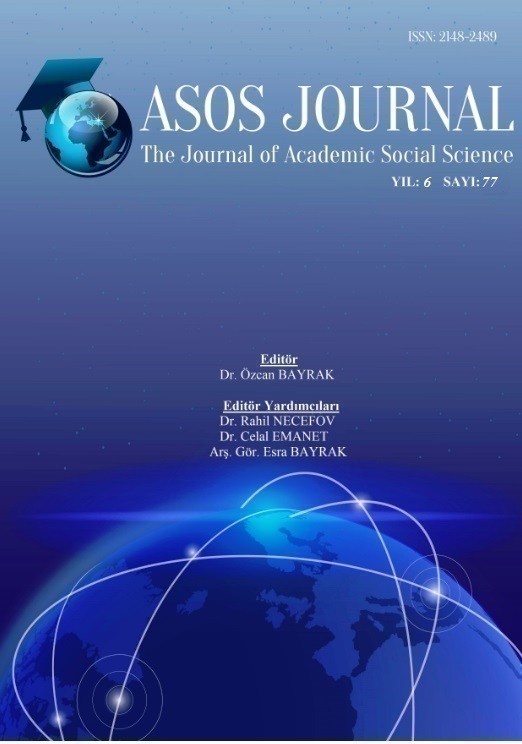Author :
Abstract
Müzik sanatı ağırlıklı olarak 19. yüzyılın ikinci yarısından itibaren diğer sanat dalları ve farklı disiplinlerle etkileşimde olmuş, modernizmle birlikte, bu etkileşim giderek disiplinlerarasılığa dönüşmüştür. Bilim ve teknolojinin ilerlemesi var olan sanat dallarının çoğu zaman değişim göstermesine ya da yeni sanat dallarının ortaya çıkmasına neden olmuştur. Bilişim teknolojisinin giderek artan bir hızla gelişmesi iletişim, bilgi edinme, ifade vb. alanlarda sınırları ortadan kaldırmıştır. Kuramın, toplumsal eleştirinin ve bilinçdışının yerini teknoloji almıştır (Kuspit, 2018: 119). Sanatın geldiği nokta estetik algının da değişmesine neden olmuş, bunun yanında sanat, sanatçı odaklı olmaktan çok dinleyici ya da izleyici odaklı bir yöne evrilmiştir. Müzik sanatında kompozitörler, yeni besteleme teknikleri arayışına girmişler, ilerleyen süreçte, bireysel metotlarını oluşturmuşlardır. Bu makalede, kaos teorisinin, bilgi teorisinin ve termodinamiğin ikinci yasası olan entropinin 20. yüzyıl müzik sanatı üzerindeki etkileri, John Cage’in eserleri örneklendirilerek incelenecektir.
Keywords
Abstract
The art of music has predominantly interacted with different fields of art and different disciplines since the second half of the 19th century. In conjunction with modernism, this interaction has evolved into interdisciplinarity. The progress of science and technology has lead to transformation of existing arts or the emergence of new fields of art. The increasing development of information technology has eradicated the limits in the fields of communication, access to information, articulation and the like. Technology has replaced theory, social critique and the unconscious (Kuspit, 2018:119). The new position which art had evolved to, has ingenerated the aesthetical perspective. Besides, art has evolved to a path focused on the listener or viewer rather than the artist. Within the art of music, composers have started to seek new composition techniques. Over time, they have established their individual methods. In this article, the effects of chaos theory, theory of knowledge and entropy – the second law of thermodynamics – on 20th century art of music will be examined through the exemplification of John Cage’s works.
Keywords
- Aktuğ, E. (2012). Müzik-mimari etkileşimi. İstanbul Üniversitesi Devlet Konservatuvarı Kon- servatoryum Dergisi, sayı 1, cilt 2, s. 27-32.
- Aktuğ, E. ve Dağdelen Z. (2016). Philip Glass ‘opera üçlemesi’ örneğinde opera sanatında minimaliz. Ege Üniversitesi Devlet Türk Musikisi Konservatuvarı Dergisi, sayı 9, s. 31-39
- Akyürek, E. (1994). Orta çağ’dan yeniçağ’a felsefe ve sanat. İstanbul: Kabalcı Yayınevi.
- Alexander, P. J. (1996). Entropy and popular culture: product diversity in the popular music recording industry. American Sociological Review, vol. 61, no. 1, pp. 171-174.
- Arnheim, R. (1971). Entropy and art an essay on disorder and order. First published by theU- niversity Of California Press, Berkeley. Adapted from the web version available at http://acnet.pratt.edu/ ̃arch543p/ readings/Arnheim.html adresinden erişildi. (ET: 07.07.2018)
- Atkins, P. (2014). Evreni yöneten dört yasa (E. Bakdur, çev.). İstanbul: Alfa Bilim.
- Biçici, F. (2016). Kaos teorisi, determinizm ve yeni bilim paradigması sürecinde sosyal bilimler ve turizm araştırmaları açısından önemi. Turizm Akademik Dergisi, 3(1), s. 29-38.
- Cage, J. (1962). John Cage. New York: Werkverzeichnis Edition Peters, p. 41
- Cohen, J. E. (1962). Information theory and music. Behavioral Science, 7:2 pp. 137-163.
- Cox, G. (2010). On the relationship between entropy and meaning in music: an exploration with recurrent neural networks. Proceedings of the Annual Meeting of the Cognitive Science Society, 32, (32), pp. 428-434.
- Culpepper, S. E. (2010). Musical time and information theory entropy. Yayınlanmamış yüksek lisans tezi, University of Iowa.
- Greene, B. (2012). Evrenin dokusu (M. Alev, çev.). Ankara: Tübitak Popüler Bilim Kitapları.
- Gündüz, M. (2006). Sosyal yaşam ve entropi yasası: dünyanın sonuna mı yaklaştık?. Atatürk Üniversitesi İktisadi ve İdari Bilimler Dergisi, cilt 20, sayı 1, s. 345-355.
- Hobsbawm, E. (2006). 20. yüzyıl 1914-1991 aşırılıklar çağı (Y. Alogan, çev.). İstanbul: Everest Yayınları.
- Jensen, M. G. (2009). John Cage, chance operations, and the chaos game: Cage and the "i ching". The Musical Times, vol. 150, no. 1907 pp. 97-102.
- Kuspit, D. (2018). Sanatın Sonu (Y. Tezgiden, çev.). İstanbul: Metis Yayıncılık.
- Laney, R., Samuels, R. ve Capulet, E. (2015). Cross entropy as a measure of musical contrast. http://oro.open.ac.uk/43681/1/contrastAAM.pdf adresinden erişildi. (ET: 09.07.2018)
- Lochhead, J. (2001). Hearing chaos. American Music, vol. 19, no. 2 pp. 210-246.
- Manzara, L. C., Witten, I. H. ve James, M. (1992). On the entropy of music: an experiment with Bach chorale melodies. Leonardo Music Journal, vol. 2, no. 1, pp. 81-88.
- Mermer, A. (2017). Yeni bilim paradigması ve kaos teorisi perspektifinden halkla ilişkiler. Akademik Sosyal Araştırmalar Dergisi, yıl: 5, sayı: 63, s. 695-705.
- Meyer, L. B. (1957). Meaning in music and information theory. The Journal of Aesthetics and Art Criticism, vol. 15, no. 4, pp. 412- 424.
- Mimaroğlu, İ. (1991). Elektronik müzik. İstanbul: Pan Yayıncılık.
- Morse, B. R. (2007). Indeterminacy, the i ching and John Cage: a new design method for lands- cape architecture. Yayınlanmamış yüksek lisans tezi, The University of Arizona.
- Ruelle, D. (2017). Rastlantı ve kaos (D. Yurtören, çev.). İstanbul: Say Yayınları.
- Salzman, E. (1974). Twentieth-century music: an introduction. New Jersey: Prentice- Hall, Inc.
- Smith, L. (2014). Kaos (H. Gür, çev.). Ankara: Dost Kitabevi.
- Wiener, N. (1954). The human use of human beings cybernetics and society. Boston: Da Capo Press.
- Yeşilorman, M. (2006). Kelebek kanadını kimden yana çırpıyor? Birleştirilmiş bilimin kıyısında kaos ve sosyal bilimler. Journal of İstanbul Kültür University Science and Engineering, cilt:4, sayı: 3, s. 77-86.
- Resim 1: i ching, hexagram. http://dcheroesrpg.wikia.com/wiki/File:Hexagrams_i-ching.jpg adresinden erişildi. (ET: 24.07.2018)
- Resim 2: music of changes. https://www.jwpepper.com/Music-of- Changes/7125388.item#/submit adresinden erişildi. (ET: 23.07.2018)
- Resim 3: fontana mix. https://medium.com/@nghinghiem04/fontana-mix-1958-john-cage- 3145720-b66c2ab3ceca adresinden erişildi. (ET:10.07.2018)
- Resim 4: music for carillon no: 4. https://www.moma.org/collection/works/33028 adresinden erişildi. (ET: 17.07.2018)
- Resim5: atlas eclipticalis. http://elisabalmaceda.com/wp-content/uploads/2012/10/atlas- eclipticalis-1961-2.jpg adresinden erişildi. (ET:17.07.2018)
- Resim 6: variations IV. https://et-musica.cl/en/john-cage-variations-iv/ adresinden erişildi. (ET: 17.07.2018)





